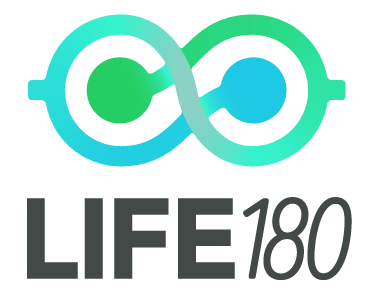Family
Protection
Family
Protection
Understanding The Importance
of Defensive Planning

Life180 was built on making sure individuals have the right financial foundation to weather life's difficult times. The financial planning world seems to only ever focus on the "sexy" offensive planning techniques while neglecting individuals
By insuring a financial foundation, it allows you to take risks in other areas, with peace of mind and confidence that your financial structure will not crumble under personal, economic, or other outside forces.
"It’s easy to plan for everything going right in life — it’s harder, but far more important, to plan for what could go wrong."
Disability Income

Your income is your greatest asset disability insurance protects it like a safety net beneath your financial future. It's like a paycheck parachute: if life throws you off course due to illness or injury, you land softly and keep moving forward.
Many individuals get this benefit through their employer, but it is important to understand the benefit and how it works.

Disability Income
Statistics

1 in 4 (25%) of today’s 20-year-olds will experience a disabling condition before they reach retirement age (Social Security Administration).Here's some stuff
90% of disabilities are caused by illnesses, not accidents including cancer, heart disease, or mental health conditions (CDA).
Over 50% of U.S. adults said they would experience financial hardship in less than a month if they lost their income due to illness or injury (LIMRA).
The average duration of a long-term disability claim is almost 3 years (Council for Disability Awareness).
Only 40% of Americans have enough savings to cover three months of living expenses, and fewer than 20% have long-term disability insurance outside of work.
Term life insurance is the simplest
way to buy peace of mind

it’s affordable protection that guarantees your loved ones are financially secure if life takes an unexpected turn. Think of it as a temporary shield: while you build wealth, raise a family, or pay off a mortgage, term coverage steps in to carry the financial weight if you're no longer here to do it.
It doesn’t build cash value — but that’s the point: it’s pure protection when you need it most. Like renting safety for your family’s future, just in case.
Term Statistics


41% of U.S. adults have no life insurance at all and many more don’t have enough (LIMRA, 2024).

Among insured households, 50% say they are underinsured, meaning their current coverage wouldn’t meet their family’s long-term needs.

The average coverage gap is estimated at $200,000–$250,000 per household, especially among parents and homeowners.
Affordability Misconceptions

80% of people overestimate the cost of life insurance especially millennials, who guess the cost is 3x what it actually is (LIMRA/Barometer Study).

In reality, a healthy 30-year-old can get a $500,000 term life policy for about $20/month less than a gym membership or Netflix + Spotify combined.
Consumer Intent vs. Action

40% of people say they intend to buy life insurance within the next year… but most never do.

The top reasons for putting it off? Confusion, procrastination, and believing it’s too expensive even when it's not.
The #1 Reason for Go Fund Me pages is due to a premature death to a family?

Get Clear. Get Aligned.
Take Control.

Ready to align your finances with your purpose? Book a Clarity Call to start your CAD journey. Want to uncover the truth about IUL? Read IUL
Exposed and transform your financial mindset.

Contacts
Address: Chandler, AZ
Sign me up!
Make smarter decisions:
Stay informed with the latest financial insights from our experts.
Copyright © 2025 LIFE180 All Rights Reserved
Health insurance isn’t just a
medical benefit

it’s a financial safety net that protects your savings from being wiped out by an unexpected illness or injury. A single hospital
visit can cost more than a new car, but the right coverage turns those potential six-figure bills into manageable costs.
Think of it as an investment in peace of mind, giving you access to care when you need it without derailing your
financial future. In a world where health equals wealth, this is your first line of defense.
How to Audit My Group Health
Insurance
Individual Insurance Hacks + Health
Insurance for Small Business Video
Why Health Insurance is a
Foundational Asset?
Types of Health Insurance Explained Video
Traditional Health Insurance (PPO/HMO)

PPO (Preferred Provider Organization)
More flexibility — see specialists without referrals
Larger provider network
Higher premiums, but easier access to care
HMO (Health Maintenance Organization)
Lower premiums, but requires referrals for specialists
Must use in-network providers
Great for routine care with one primary doctor


High-Deductible
Health Plan (HDHP)

Lower monthly premiums, higher out-of-pocket costs if you get sick
Pairs well with an HSA (Health Savings Account) tax-free savings for medical expenses
Good for healthy people who rarely visit the doctor
Health Sharing Plans (e.g., Christian/Community-Based)

Not technically insurance — it’s cost-sharing among members
Often lower cost, but fewer legal protections
Limited provider networks and may exclude pre-existing conditions
Great for people who align with the group’s values and want a low-cost option

Health Statistics

Coverage & Access Gaps
Out-of-Pocket Costs & Financial Risk

As of 2024, 26 million Americans (around 7.9%) still have no health insurance (U.S. Census Bureau).

The average annual deductible for individual coverage in employer plans is now over $1,700, and $3,000–$7,500 is common for HDHPs (KFF).

Nearly half of uninsured adults say they remain uninsured because coverage is too expensive, even with subsidies (KFF).

Medical bills are the #1 cause of personal bankruptcy in the U.S., contributing to over 66% of bankruptcies filed (American Journal of Public Health).

1 in 3 Americans skipped medical care in the past year due to cost concerns, even if they had insurance.

A single hospital stay can cost $30,000 to $100,000+ without insurance.
Misconceptions & Missed Opportunities

1 in 3 Americans skipped medical care in the past year due to cost concerns, even if they had insurance.

1 in 3 Americans skipped medical care in the past year due to cost concerns, even if they had insurance.
Get Clear. Get Aligned. Take Control.

Clarity creates confidence. Let’s cut through the noise, align your money with your values, and design a financial path you can actually trust.
